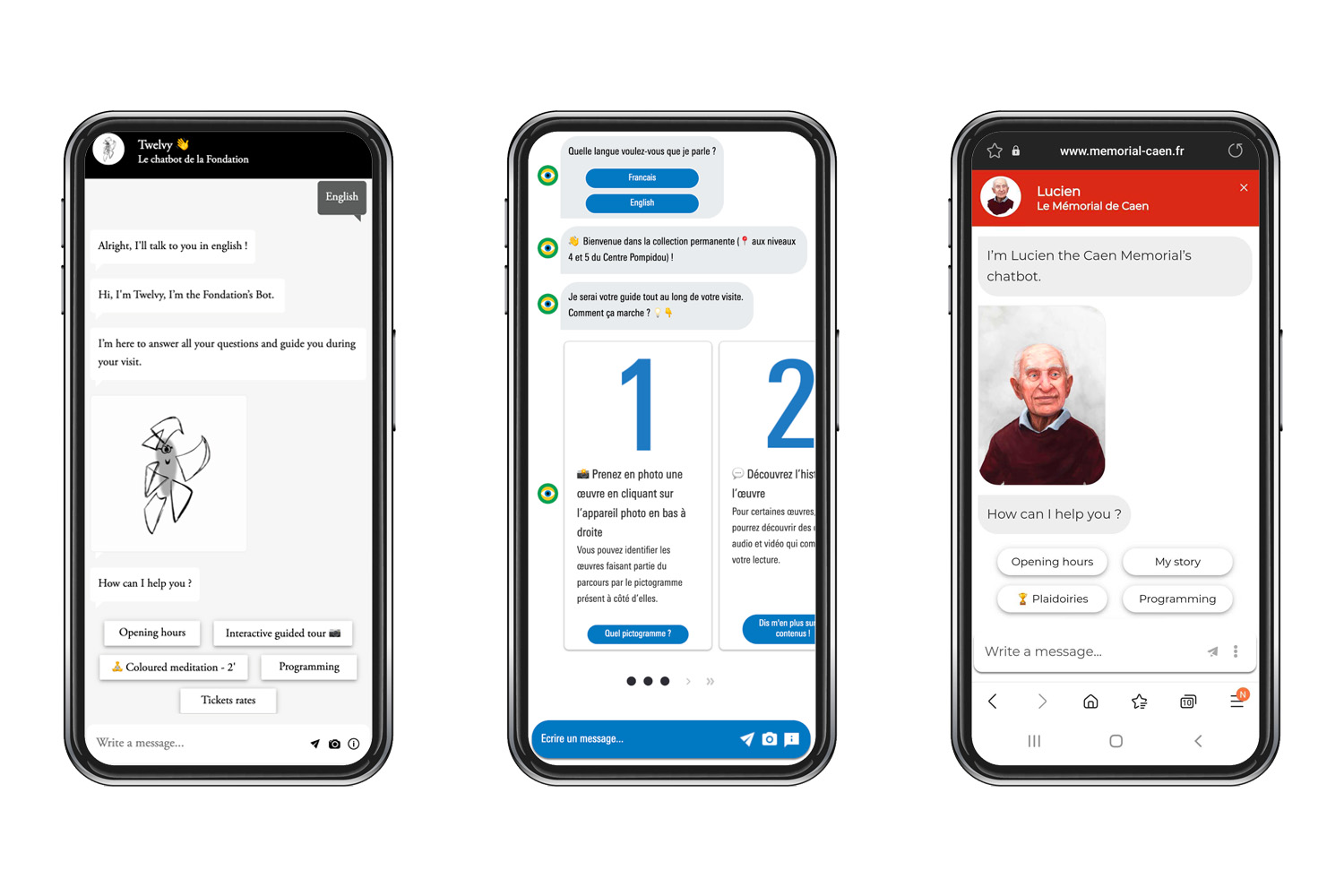#TECH
6 MINUTES
Multilingual chatbot:
the best feature to inform international visitors
744 million.
They were 744 million to travel to Europe in 20191. It represented more than half of the world’s international arrivals!
On top of that, 48% of international tourists come from Europe. Europeans are the ones that travel the most throughout the world!
There is no doubt that culture and institutions attract many visitors from all over the world.
Welcoming these millions of visitors is a challenge for institutions. Indeed, most of these visitors do not speak multiple languages. You must provide them with information in their native language. Museum reception staff are the first possible answer, nevertheless they cannot communicate in all languages. Ask Mona’s multilingual chatbot is a simple and complementary solution.

This new feature allows cultural institutions to optimize international visitors’ experience.
We know the coronavirus pandemic braked tourism. Not all audiences have returned to traveling yet, but it is clearly on the right path!
Therefore, allow them to reconnect with your institution and find their way back to you. Discover how to improve the experience of your international visitors with this multilingual feature!
Ask Mona chatbots: from bilingual to multilingual
Until now, our artificial intelligence tools were only available in English and French. For example, Twelvy, the chatbot of the Louis Vuitton Foundation, addresses its visitors in both languages. With 3 million visitors a year, the Centre Pompidou also called on our services to provide them with a bilingual tool!
Many regional sites also welcome audiences from all over the world. Did you know the Caen Memorial is one of the most visited places in France? Lucien, its conversational agent, provides information to visitors in English and French.

Since 2017, Ask Mona has grown and seen an increase in the number of projects. Today, the Ask Mona teams are thrilled to support more than 80 cultural institutions in Europe. These institutions radiate and attract visitors from all over the world.
After implementing and analysing this bilingual tool for several months, we decided to go further. We wanted to make it easier for you to assist a broader range of audiences. As you may know, our main concern is to help you welcome your publics in the best conditions, from your website’s homepage to your institution’s steps!
Here is how we deployed this new feature.
Both our technical and editorial teams worked on this function.
Our technical team developed and trained the artificial intelligence so it would be able to understand and speak other languages.
Our editorial team takes care of transcribing the tone of your institution in the different languages you choose for your chatbot. We are talking about the famous idioms that do not always have a literal translation.
Let’s take some examples from the chatbot of the Chillon Castle to illustrate this:
- I line of my code is tickling, but otherwise I’m fine 🙂
Eine Codezeile ist etwas holprig, aber ansonsten geht es mir gut 🙂
- I simply adore the harp. The instrument and the music it produces are divine! Listen to me harping on… 🎼
J’adore la harpe. C’est un instrument de musique divin ! Est-ce que je vous donne le “la”? 🎼
- Let’s leave the jokes to the troubadours and trouvères, if you please!
Je ne fais pas de blagues… je suis régente pas folle du roi !
And there are many more! Don’t worry, when translating your content, we will make sure to transcribe it correctly so that your DNA crosses borders!
At Ask Mona, your visitors are as important as you. By adding the multilingual feature to your practical information and digital guide chatbots, we go even further. We know hiring staff who will be able to inform the public in more than four languages is not an easy task.
The multilingual chatbot allows you to relieve your receptionists and accompany foreign visitors in the best possible way!
Thus, by adding our technical skills to our editorial expertise, we have made the multilingual chatbot accessible to cultural institutions!
Our new functionality allows you to provide content in 6 languages, including :
- French: let’s not forget that French is the 5th most spoken language!
- English: more than 1 billion people speak this language. Also, it is considered an official language in more than 50 countries. It is a must for welcoming your audiences!
- Spanish: more than 538 million people speak Spanish worldwide. It is the official language in most South American countries and Spain. Providing content in Spanish will give you access to a large community.
- Portuguese: spoken by more than 252 million people, this language is widespread worldwide.
- Italian: Italian represented 13% of the languages spoken in Europe in 2014. It is necessary to be able to welcome this population with the right content!
- German: this language is one of the most spoken in Europe!
The multilingual chatbot offer: how does it work?
Your website is essential for your visitors’ experience. But translating it entirely into several languages can be long, tedious, and expensive!
By providing your audience with a chatbot, you offer them an essential channel of information for their visit. This mastered information channel will allow you to translate your chatbot’s scenarios only. As a result, the translation will be more targeted, cost less, and require less time.
Our turnkey solution allows you to manage your chatbot’s content directly through your Ask Mona back-office. We designed it to save you time in translating your content.
Also, the improvement of the chatbot’s performance is efficient in all the languages available. There will be no additional test period to train the chatbot if you decide to add a language. Furthermore, you only have to click on the language button (illustrated by flags) in your back office to activate a new language. Therefore, you can make your tool evolve as your needs change.
There are two things to consider when you want to offer access to a new language in your chatbot:
- Content that will be automatically translated: all features and related sentences, for example, “opening hours” will become “horaires d’ouverture” in French, or “programming” will become “programmierung” in German.
- Content that needs manual translation: personalized questions with answers and scenarios. Our editorial department, specializing in art history, offers translation support to make it easier for you.
This new functionality can easily be added up to your chatbot. Contact our team to learn more!
Ask Mona, the borderless visitor experience
Our chatbots are available in English, French, Spanish, German, Portuguese, and Italian. But what about other languages?
Do not worry, we thought about everything! And especially if a visitor does not know how to express himself well in one of these 6 languages. If this happens (and it certainly will) the visitor can ask in his native language. Then, he will receive an answer in the language he wants and understands best among those available.
Our chatbots are able to understand 25 languages! Thus, it is possible for people who speak other languages than those offered to obtain the information needed.
Let’s take the case of a Swedish person who speaks French better than English. By making the request to change the language in Swedish (byta språk), the chatbot understands and proposes other available languages.
To illustrate all this, we present you our first multilingual chatbot: the one of the Chillon castle!
This Swiss monument offers content in 3 languages to its visitors: English, French, and German! In each of these languages, the chatbot keeps its identity and the same tone. So, meet Bonne of Bourbon as soon as possible!
We have designed this tool to provide your visitors with the most fluid and pleasant experience possible.
Our products are webchats, which means that they work on a browser. The chatbot retrieves the user’s language information through the browser and directly proposes content in the corresponding language.
However, if the visitor wishes to change the language, he can do so by modifying his choice. Then, he has to ask the chatbot, which will propose the available languages. It will only take a few seconds!
What do you think about it?
We hope we have convinced you that the multilingual chatbot is the solution to answer and support your international visitors to your institution.
So let’s meet to improve together your international audiences’ experience 😉
Get in touch with our team, and we will set up a tailor-made project.








